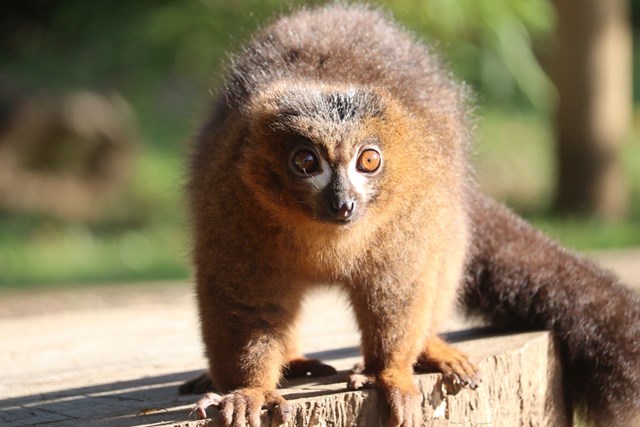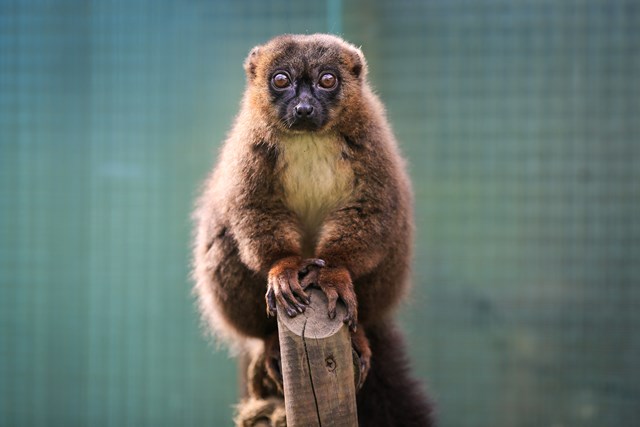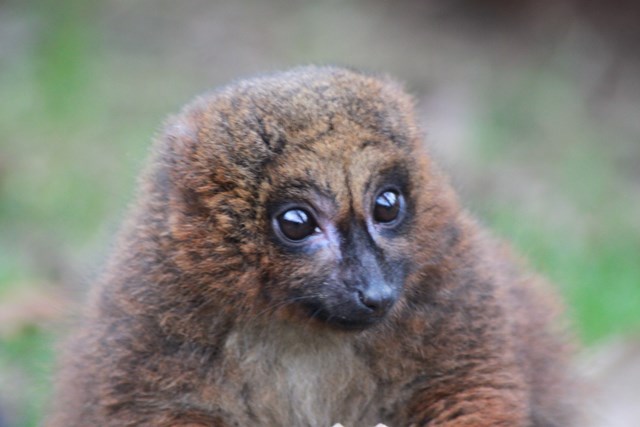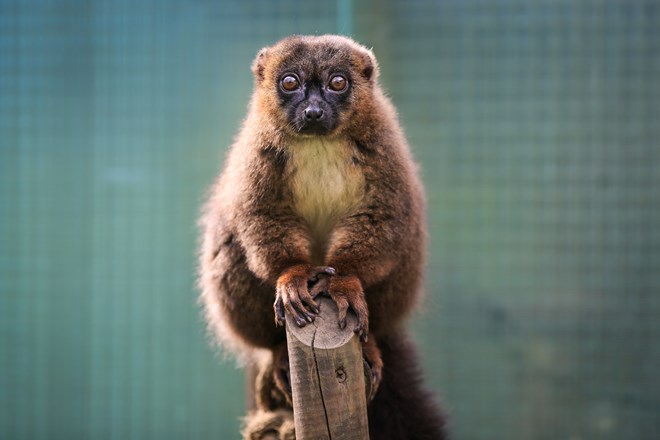
Overview
The red-bellied lemur is one of the rarest members of its family, Eulemur. Despite this, it is one of the least commonly kept in captivity.
Although they are named red-bellied, it is only the males who have this feature, the females have a white underbelly. Their distinctive call sounds like a pig grunting, but they will also make meow-like calls.
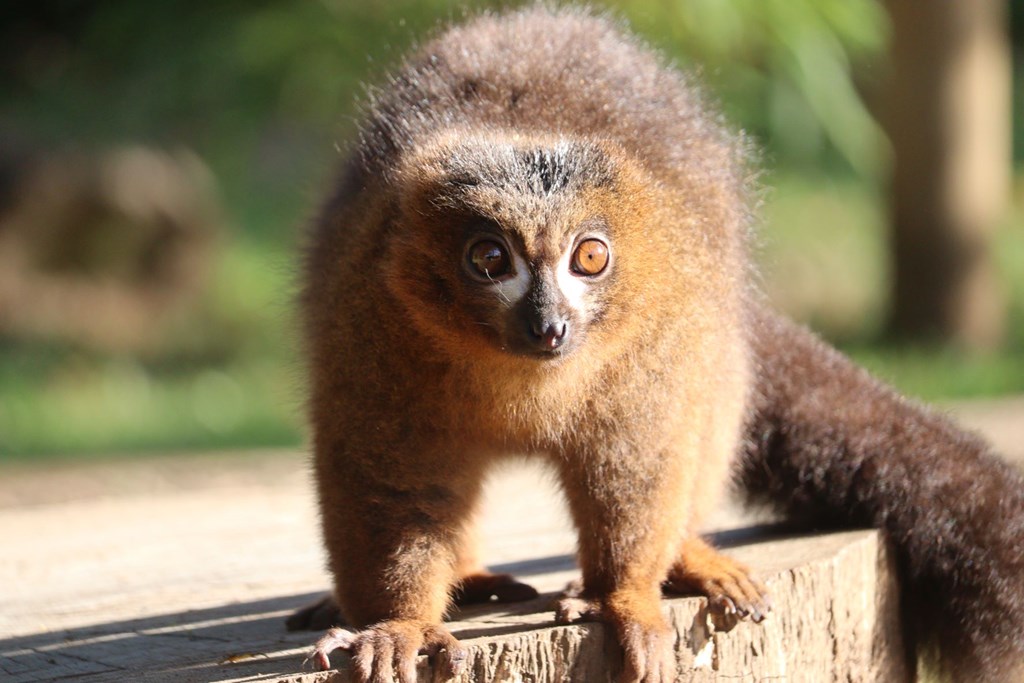
All about us
| Distribution: | Eastern Madagascar |
|---|---|
| Habitat: | Lowland forests |
| Height: | Body length 50cm to 55cm, tail length 60cm to 65cm |
| Weight: | 3kg - 4.5kg |
| Lifespan: | In the wild 18 to 20 years, in captivity 20 to 25 years |
| Threats: | Main threats are habitat loss, and capture for the meat trade |
Scientific name: Eulemur rubriventer
There is a small group of red-bellied lemurs at Woburn Safari Park that live alongside the ring-tailed lemurs and black-and-white ruffed lemurs. You will often find them sleeping in their favourite tree, or the youngsters jumping around in the bamboo playing.

red-bellied lemur facts
- Physical features
- Diet
- Social structure, breeding & communication
- Husbandry and enrichment
- Threats & conservation
They are a sexually dimorphic species, meaning the male and female differ in appearance. Both sexes are mostly a dark chestnut brown. The female’s underbelly is a creamy white, with the rest of the body chestnut brown. The males have small teardrop shaped white patches under their eyes, with the rest of the body chestnut brown. The Young males have the female colouration until around two years when they start to sexually mature.
They are agile climbers, with hands similar in structure to a human hand, including an opposable thumb, allowing them to grip when climbing and to hold objects. Their back feet feature a large modified big toe allowing them to grip with their hind feet just as easily.
They have a long thick tail, which although not prehensile, it is vital for balance when climbing and jumping, and is longer than their body length.
Lemurs have a much more developed sense of smell than other primates. They have an enlarged Jacobson’s organ, a sensory organ in their nose which allows them to read pheromones and other chemicals. Scent marking is an important behaviour for the red-bellied lemur, using scent glands located on the head of the males, and the around the genitals of the females.
The red-bellied lemur has a diet mainly consisting of fruit, and has been found to forage on over seventy species of plant. It will also feed on flowers, leaves, and invertebrates depending on the season.
Because of their fruit heavy diet they act as an important seed dispenser throughout the forest.
They have been found to eat toxic millipedes, when eating them they will first drool on them, which is thought to help neutralize the toxins to make them edible.
Red-bellied lemur are one of few lemur species which form groups around a monogamous adult pair. The group of two to six will usually consist of the breeding pair and their offspring.
Females are dominant in this species. With the female leading the group to travel and feed together throughout their 10 to 20 hectare home range, which is relatively small compared to other large-bodied lemur species. While feeding one member of the group will act as sentinel to warn the group of predators.
Females will give birth to one infant each year, which she will carry on her belly, and then later her back. The infant will ride on the backs of both parents, then after a month of so the female will rejects it so the male carries it until it is around 100 days old and becomes independent.
Males and females both reach sexual maturity at around two years of age.
As their home range isn’t very large vocal communication is not very important for this species, however scent marking is a vital tool, used by both sexes to mark territories.
This species is catheremal, meaning they are intermittently active during both the night and day. This pattern of activity is dependent on the season and food availability.
In the wild lemurs would be found up in the mid canopy of the trees, very rarely on the ground. To allow them to mimic this natural behaviour their enclosure is designed with large trees to traverse, and ropes connecting different areas. The lemurs use these ropes and branches to manoeuvre around the enclosure, promoting exercise, and demonstrating their natural climbing and jumping abilities when doing so.
Wild lemurs will spend most of their day foraging for food. To mimic this, and to keep our lemurs active, we spread their feed throughout the enclosure, hiding food, placing it high up, making it hard to reach, and changing our feeding locations daily to keep them on their toes.
Lemurs are a small brained and less intelligent group of species, so we have to make sure our enrichment isn’t too complicated, for example hiding food in puzzle feeders may prove too difficult for them to figure out.
Madagascar can have changing weather, from rain to severe heat and so the lemurs are adapted to both, but we give them a heated house all year round, with the option to venture into the cold, to mimic the temperature range in Madagascar.
The natural predators of red-bellied lemurs are the fossa and various raptors.
The red-bellied lemur is found in at least nine protected areas in Madagascar, including five National Parks and two Strict Nature Reserves. It is thought to be one of the rarest species of its family, Eulmur, and is not as well kept in captivity as some other species.
The main threat to lemurs is habitat loss, due to slash-and-burn agriculture, logging, and mining. This destroys habitats, and vital forest corridors which allow groups to move between locations. Almost 90% of the natural forest in Madagascar has been destroyed since human habitation of the island.
Although a large amount of conservation work is going on there is still a lot to do in terms of educating the people to the plight of all lemur species, and recovering the habitat before reintroduction can be a viable option. There are several conservation projects ongoing in Madagascar, including education projects, habitat repair, and eco-tourism. Some reintroductions of captive bred lemurs have been trialled in the past, but with mixed results.
They are part of an EEP, European Endangered Species Programme. The EEP is the most intensive type of population management for a species kept in European zoos. Each EEP has a coordinator, who is assisted by a Species Committee. They are responsible for collecting all the data on births, deaths, and transfers, carrying out demographical and genetical analyses, and producing a plan for the future management of the species. Together with the Species Committee, recommendations are made each year on which animals should breed or not breed, which individual animals should go from one zoo to another, and so on.
The red-bellied lemur is classified as Vulnerable on the IUCN Red List, and is listed on Appendix I of CITES, meaning the movement of this species is greatly controlled and restricted, trade in specimens of these species is permitted only in exceptional circumstances.
